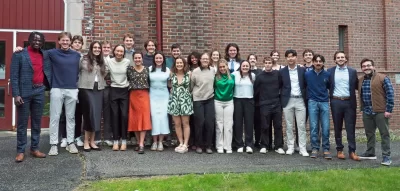Home
Bates Math: Class of 2025
A dynamic subject, with connections to many disciplines, mathematics is an integral part of a liberal arts education, and is increasingly vital in understanding science, technology, and society. Entry-level courses introduce students to basic concepts and hint at some of the power and beauty behind these fundamental results. Upper-level courses and the capstone experience provide majors with the opportunity to explore mathematical topics in greater depth and sophistication, and to delight in the fascination of this important discipline.
Bates Math: Class of 2025
Pictured here are our 2025 graduates.
Photo credit: Laura Storch, Assistant Professor of Mathematics
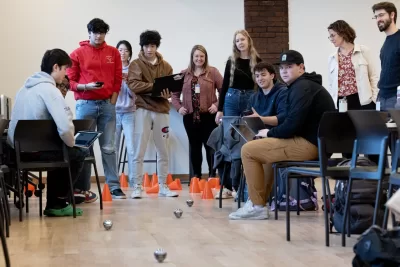
Featured Story
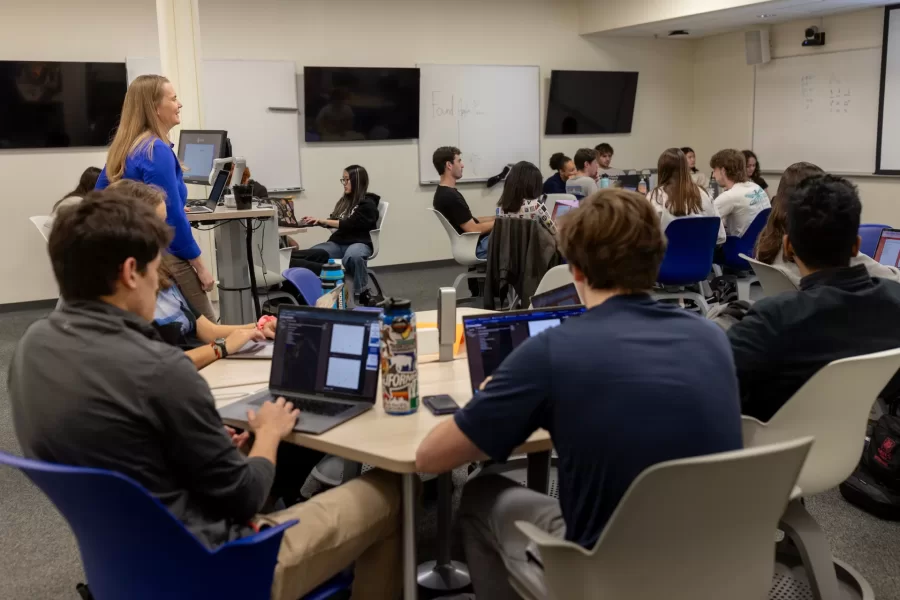
Associate Professor of Mathematics Katy Ott teaches “Mathematics for Justice” course in Carnegie 339 on Thursday, Sept. 28, at 1:10 p.m. MATH 233 – Mathematics for Social Justice This course teaches quantitative literacy, critical thinking and problem solving skills in a socially relevant context. Students use mathematics as a powerful analytic framework for understanding and developing realistic solutions to issues of social, political, and economic justice. The overarching goal of this course is for students to develop the ability and inclination to use mathematics to understand, and improve, the world around them. Prerequisite(s): MATH 106. Recommended background: MATH 205.

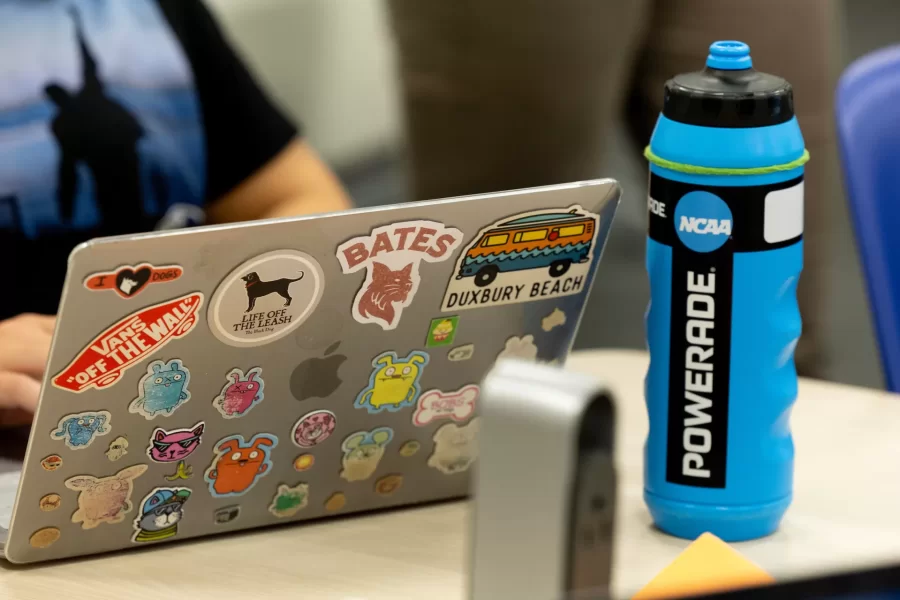
Associate Professor of Mathematics Katy Ott teaches “Mathematics for Justice” course in Carnegie 339 on Thursday, Sept. 28, at 1:10 p.m. MATH 233 – Mathematics for Social Justice This course teaches quantitative literacy, critical thinking and problem solving skills in a socially relevant context. Students use mathematics as a powerful analytic framework for understanding and developing realistic solutions to issues of social, political, and economic justice. The overarching goal of this course is for students to develop the ability and inclination to use mathematics to understand, and improve, the world around them. Prerequisite(s): MATH 106. Recommended background: MATH 205.
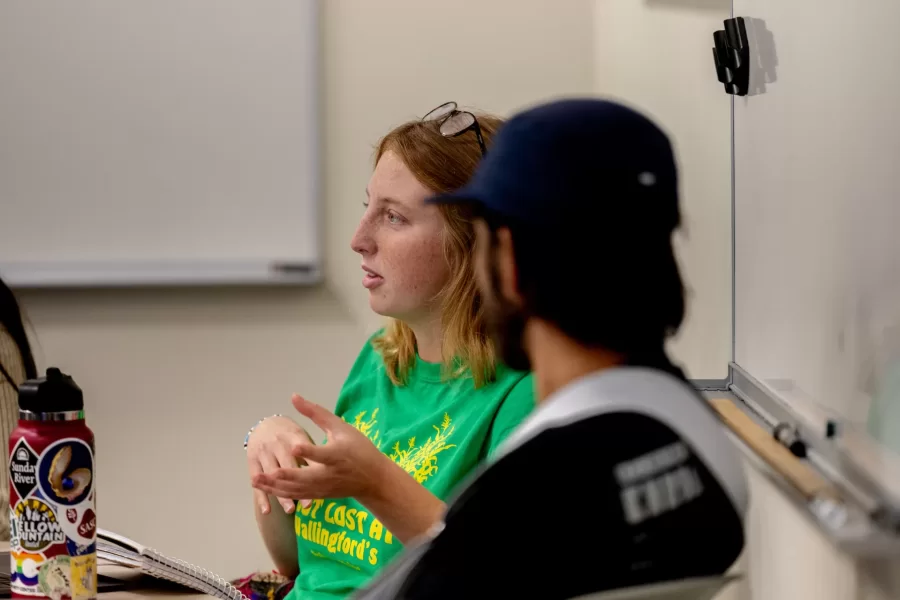
Associate Professor of Mathematics Katy Ott teaches “Mathematics for Justice” course in Carnegie 339 on Thursday, Sept. 28, at 1:10 p.m. MATH 233 – Mathematics for Social Justice This course teaches quantitative literacy, critical thinking and problem solving skills in a socially relevant context. Students use mathematics as a powerful analytic framework for understanding and developing realistic solutions to issues of social, political, and economic justice. The overarching goal of this course is for students to develop the ability and inclination to use mathematics to understand, and improve, the world around them. Prerequisite(s): MATH 106. Recommended background: MATH 205.
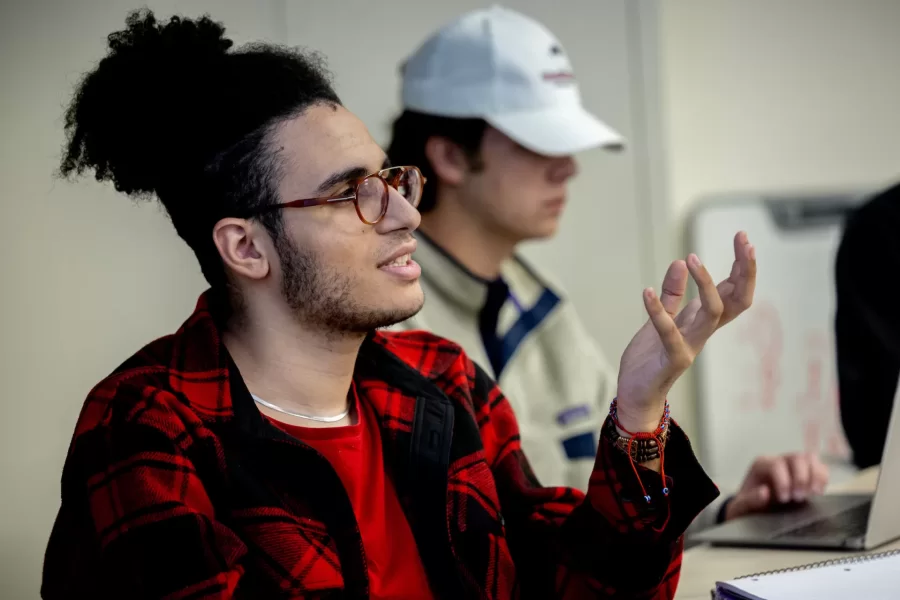
Associate Professor of Mathematics Katy Ott teaches “Mathematics for Justice” course in Carnegie 339 on Thursday, Sept. 28, at 1:10 p.m. MATH 233 – Mathematics for Social Justice This course teaches quantitative literacy, critical thinking and problem solving skills in a socially relevant context. Students use mathematics as a powerful analytic framework for understanding and developing realistic solutions to issues of social, political, and economic justice. The overarching goal of this course is for students to develop the ability and inclination to use mathematics to understand, and improve, the world around them. Prerequisite(s): MATH 106. Recommended background: MATH 205.
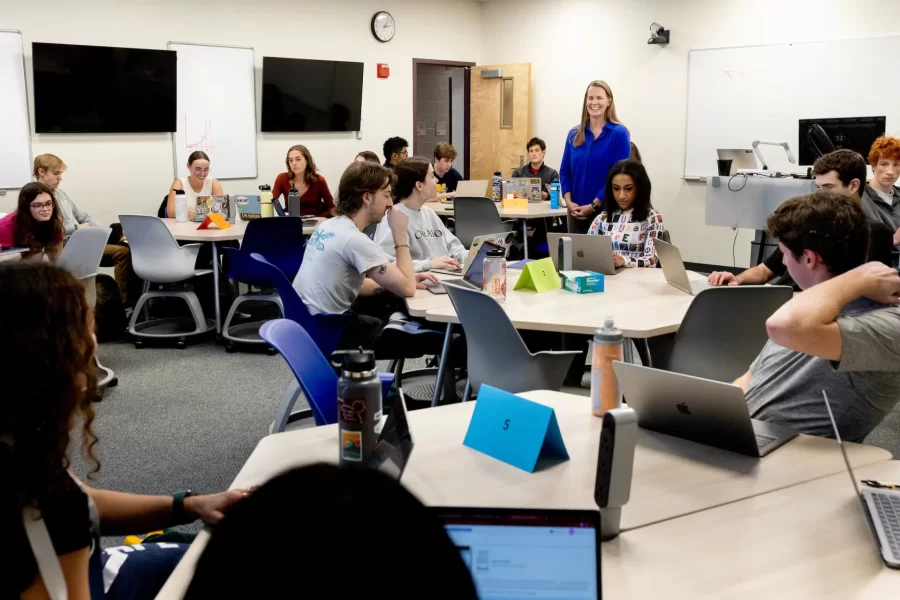
Associate Professor of Mathematics Katy Ott teaches “Mathematics for Justice” course in Carnegie 339 on Thursday, Sept. 28, at 1:10 p.m. MATH 233 – Mathematics for Social Justice This course teaches quantitative literacy, critical thinking and problem solving skills in a socially relevant context. Students use mathematics as a powerful analytic framework for understanding and developing realistic solutions to issues of social, political, and economic justice. The overarching goal of this course is for students to develop the ability and inclination to use mathematics to understand, and improve, the world around them. Prerequisite(s): MATH 106. Recommended background: MATH 205.
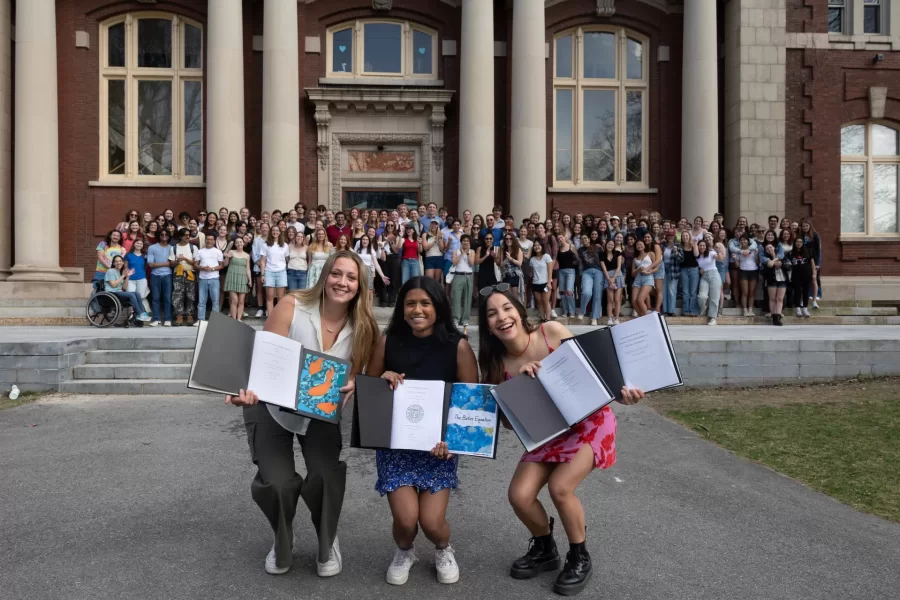
Francisca, Mallika and I have been friends since the first day of freshman year as we all lived in Page Hall on the 4th floor. Francisca and Mallika were first-year roommates and Francisca and Livia met through their Calc II class and became closer after forming a study group for it. After the first day of classes, Livia invited Francisca to her birthday get-together that night, Mallika tagged along, and the rest was history! We all stayed very good friends for the entirety of our college careers and are very thankful for having each other through a very stressful freshman year. Living through freshman year with all of the COVID restrictions brought us closer together and here we are four years later still best friends (and all Math majors). For the binding today, Mallika Jena and I bound our math capstone first. We took Katy Ott’s math capstone class titled Mathematical Exposition, where our class produced a collaborative final math magazine for the audience of undergraduate mathematics majors or potential majors. The magazine is titled, The Bates Equation, and specifically includes Mallika’s and I’s written work that analyzes primary sources of mathematical literature associated with the Pythagorean theorem, which we all know and love. Your name: Maria Francisca Rocha Hometown: Porto, Portugal Majors: Biochemistry, Mathematics The title of each of your theses and advisor: • “Mathematical Model of the Response of Bacterial Biofilms to Antibiotic Treatments” Professor Colleen O’Loughlin.- Professor Meredith Greer, Mathematics department • “Characterizing the morphology of Staphylococcus epidermidis bacterial biofilms using scanning electron microscopy” Guests: I am part of the frisbee team, I work at the Office of Global Education, and I am one of the Managers of the Ronj, so I invited my teammates, coworkers, and friends from those groups and beyond! Quote: It was heartwarming to see all my friends gathered to celebrate the culmination of my work a

Small, but sophisticated. That’s what first-year students of Professor of Mathematics Meredith Greer discovered about one kind of small robot during a visit to Bates by a team of Lewiston Public Schools educators on Nov. 14. The team of instructional specialists and tech coaches brought Sphero BOLT robots with them during the morning visit to Chase Hall Lounge. Designed for educational and recreational purposes, they’re often used in schools to teach coding and robotics. From left, first-year students Darien Chiang of Quincy, Mass., Julian Tilney of Arlington, Mass., and Finn Sheehy of Burlingame, Calif., get a handle on how to program the robots. The students are in Greer’s First-Year Seminar, “Learning Math Using Crafts, Coding, and Games,” which investigates “how humans think about math at age 5, age 12, or age 18 and beyond.” During the semester, the students focused on learning through a variety of methods, including hands-on crafts, open-ended class meetings, and age-appropriate computer coding. This was the educators’ third visit to the course, and for each visit, they brought with them age-appropriate robots. Connecting with the Lewiston educators, and gaining insights into “specific activities they do with the robots at specific grade levels,” Greer explains, “has given us multiple chances to connect our studies with specific grade-level-based math learning standards that are used across the state of Maine.” For the Lewiston educators, the three visits reflect growing outreach efforts into their community. “They were both enthusiastic and generous about bringing these lessons into our classroom,” says Greer. “Moving forward, we are continuing to think about ongoing collaborations.”
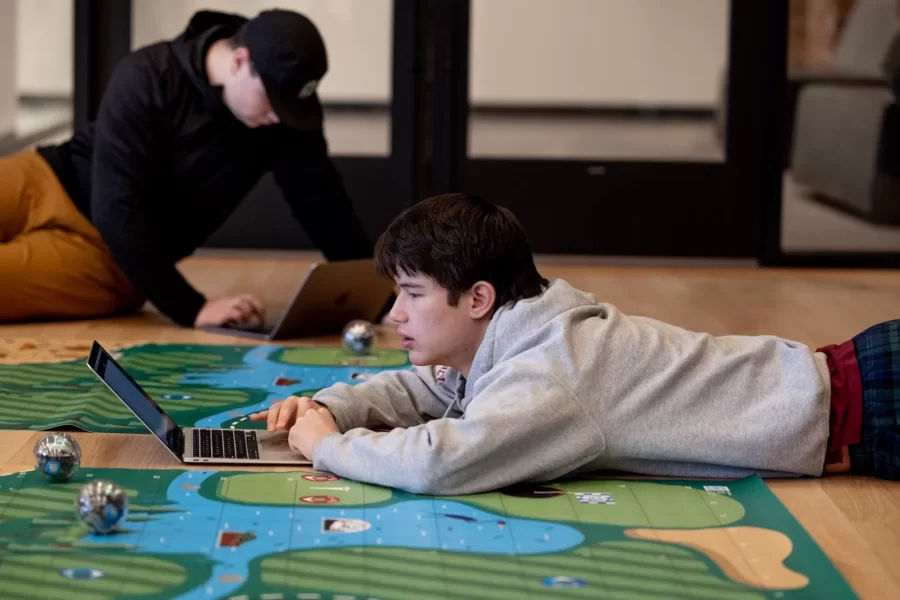
Small, but sophisticated. That’s what first-year students of Professor of Mathematics Meredith Greer discovered about one kind of small robot during a visit to Bates by a team of Lewiston Public Schools educators on Nov. 14. The team of instructional specialists and tech coaches brought Sphero BOLT robots with them during the morning visit to Chase Hall Lounge. Designed for educational and recreational purposes, they’re often used in schools to teach coding and robotics. From left, first-year students Darien Chiang of Quincy, Mass., Julian Tilney of Arlington, Mass., and Finn Sheehy of Burlingame, Calif., get a handle on how to program the robots. The students are in Greer’s First-Year Seminar, “Learning Math Using Crafts, Coding, and Games,” which investigates “how humans think about math at age 5, age 12, or age 18 and beyond.” During the semester, the students focused on learning through a variety of methods, including hands-on crafts, open-ended class meetings, and age-appropriate computer coding. This was the educators’ third visit to the course, and for each visit, they brought with them age-appropriate robots. Connecting with the Lewiston educators, and gaining insights into “specific activities they do with the robots at specific grade levels,” Greer explains, “has given us multiple chances to connect our studies with specific grade-level-based math learning standards that are used across the state of Maine.” For the Lewiston educators, the three visits reflect growing outreach efforts into their community. “They were both enthusiastic and generous about bringing these lessons into our classroom,” says Greer. “Moving forward, we are continuing to think about ongoing collaborations.”
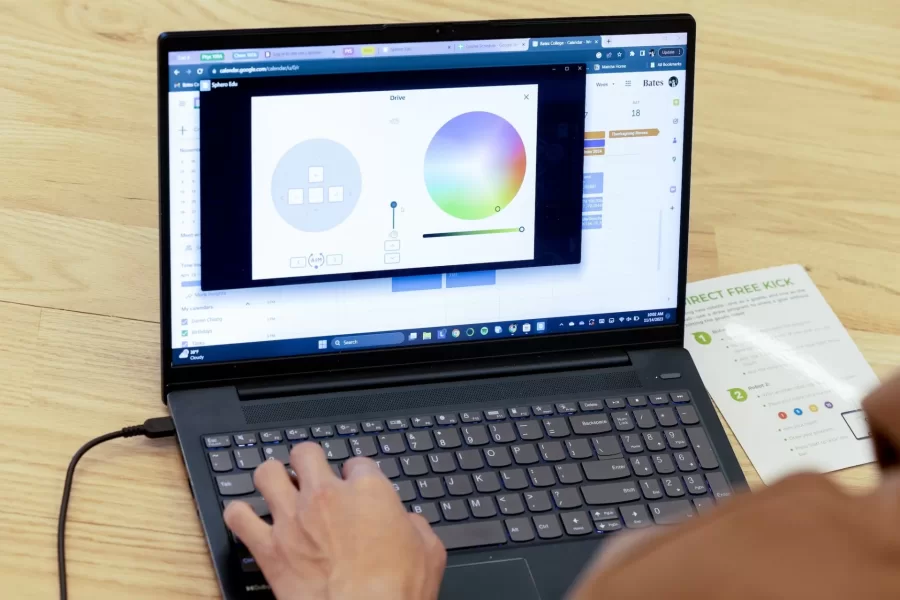
Small, but sophisticated. That’s what first-year students of Professor of Mathematics Meredith Greer discovered about one kind of small robot during a visit to Bates by a team of Lewiston Public Schools educators on Nov. 14. The team of instructional specialists and tech coaches brought Sphero BOLT robots with them during the morning visit to Chase Hall Lounge. Designed for educational and recreational purposes, they’re often used in schools to teach coding and robotics. From left, first-year students Darien Chiang of Quincy, Mass., Julian Tilney of Arlington, Mass., and Finn Sheehy of Burlingame, Calif., get a handle on how to program the robots. The students are in Greer’s First-Year Seminar, “Learning Math Using Crafts, Coding, and Games,” which investigates “how humans think about math at age 5, age 12, or age 18 and beyond.” During the semester, the students focused on learning through a variety of methods, including hands-on crafts, open-ended class meetings, and age-appropriate computer coding. This was the educators’ third visit to the course, and for each visit, they brought with them age-appropriate robots. Connecting with the Lewiston educators, and gaining insights into “specific activities they do with the robots at specific grade levels,” Greer explains, “has given us multiple chances to connect our studies with specific grade-level-based math learning standards that are used across the state of Maine.” For the Lewiston educators, the three visits reflect growing outreach efforts into their community. “They were both enthusiastic and generous about bringing these lessons into our classroom,” says Greer. “Moving forward, we are continuing to think about ongoing collaborations.”
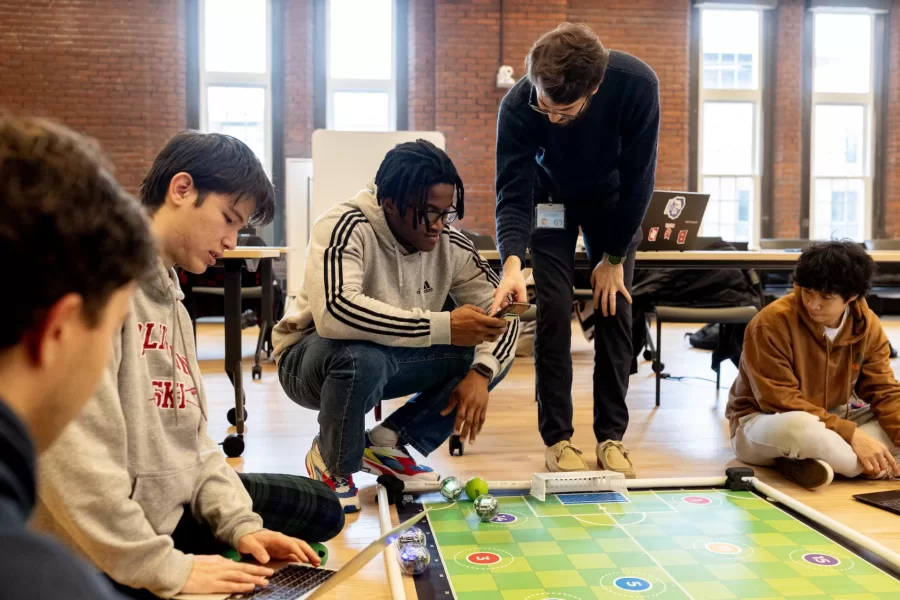
Small, but sophisticated. That’s what first-year students of Professor of Mathematics Meredith Greer discovered about one kind of small robot during a visit to Bates by a team of Lewiston Public Schools educators on Nov. 14. The team of instructional specialists and tech coaches brought Sphero BOLT robots with them during the morning visit to Chase Hall Lounge. Designed for educational and recreational purposes, they’re often used in schools to teach coding and robotics. From left, first-year students Darien Chiang of Quincy, Mass., Julian Tilney of Arlington, Mass., and Finn Sheehy of Burlingame, Calif., get a handle on how to program the robots. The students are in Greer’s First-Year Seminar, “Learning Math Using Crafts, Coding, and Games,” which investigates “how humans think about math at age 5, age 12, or age 18 and beyond.” During the semester, the students focused on learning through a variety of methods, including hands-on crafts, open-ended class meetings, and age-appropriate computer coding. This was the educators’ third visit to the course, and for each visit, they brought with them age-appropriate robots. Connecting with the Lewiston educators, and gaining insights into “specific activities they do with the robots at specific grade levels,” Greer explains, “has given us multiple chances to connect our studies with specific grade-level-based math learning standards that are used across the state of Maine.” For the Lewiston educators, the three visits reflect growing outreach efforts into their community. “They were both enthusiastic and generous about bringing these lessons into our classroom,” says Greer. “Moving forward, we are continuing to think about ongoing collaborations.”
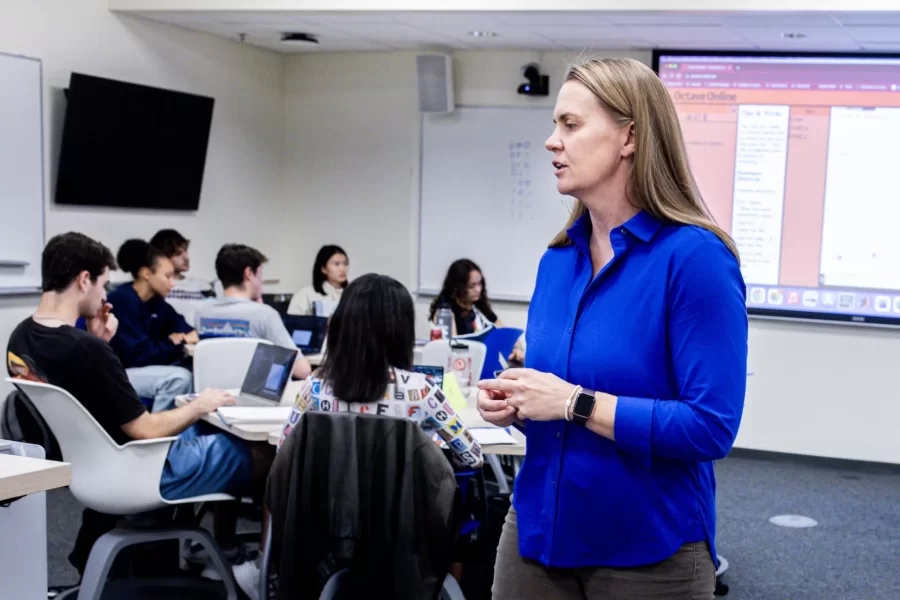
Associate Professor of Mathematics Katy Ott teaches “Mathematics for Justice” course in Carnegie 339 on Thursday, Sept. 28, at 1:10 p.m. MATH 233 – Mathematics for Social Justice This course teaches quantitative literacy, critical thinking and problem solving skills in a socially relevant context. Students use mathematics as a powerful analytic framework for understanding and developing realistic solutions to issues of social, political, and economic justice. The overarching goal of this course is for students to develop the ability and inclination to use mathematics to understand, and improve, the world around them. Prerequisite(s): MATH 106. Recommended background: MATH 205.
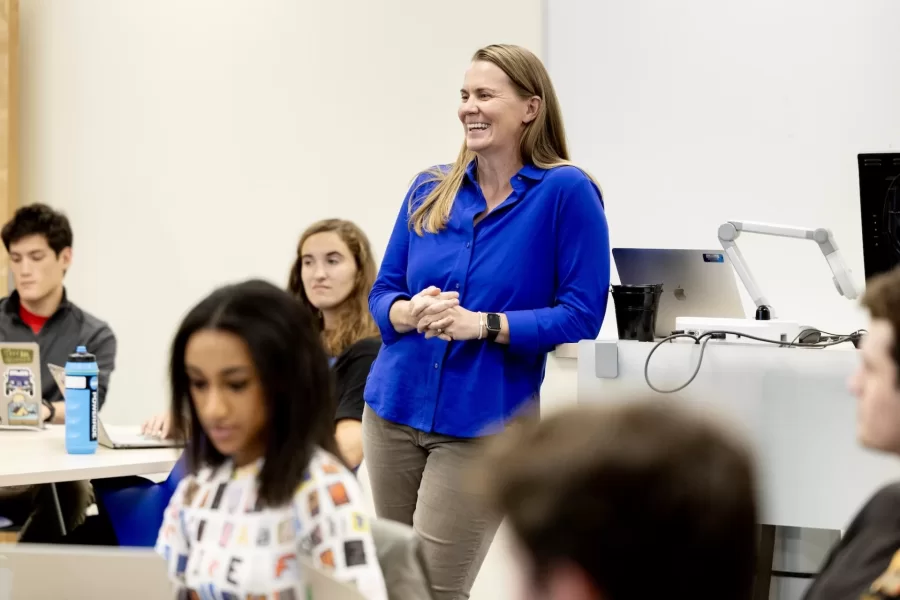
Associate Professor of Mathematics Katy Ott teaches “Mathematics for Justice” course in Carnegie 339 on Thursday, Sept. 28, at 1:10 p.m. MATH 233 – Mathematics for Social Justice This course teaches quantitative literacy, critical thinking and problem solving skills in a socially relevant context. Students use mathematics as a powerful analytic framework for understanding and developing realistic solutions to issues of social, political, and economic justice. The overarching goal of this course is for students to develop the ability and inclination to use mathematics to understand, and improve, the world around them. Prerequisite(s): MATH 106. Recommended background: MATH 205.

Meredith Greer’s upper-level “Advanced Topics in Biomathematics” today at 1:10-2:30pm in Hathorn 207. Mathematics students in the class: Sam Findlen-Golden ’20, math major El Khansaa Kaddioui ’20, math and economics double major In front fow with hat and black vest speaking with Meredith. They are reviewing simplest compartmental model of diseases spread. Differential equations describe how disease moves. They are learning the details of that model so they know the groundwork and can then tackle more complicated models. Three students together in the back, from left: Gabe Nelson ’20, South Burlington, Vt. Adena Bernot ’20, Old Westbury, N.Y. Josie Blanchon ’20, Wash D>C> Front row, classroom right: Luca Polar ’20, Budapest Jason Canaday ’20 Two women together Helen Daigle ’20 in lilac Casey Snow ’20, stripes Rear, classroom right XuChong Show ’20 Shanghai, China Katie Leeke ’20, Minnetonka, Minn.
